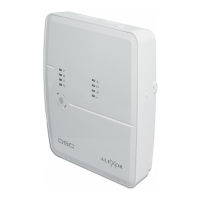
Do you have a question about the DSC ALEXOR and is the answer not in the manual?
| Partitions | 2 Partitions |
|---|---|
| Backup Battery | 12V 7Ah rechargeable battery |
| Power Supply | 16.5VAC |
| Users | Up to 48 users |
| Humidity | non-condensing |
| Communication | Dual-path communication (cellular and internet) |
Details regulatory compliance for the device according to FCC rules, including interference and usage guidelines.
Outlines regulatory compliance and technical specifications as per Industry Canada standards for the device.
Critical guidelines to reduce risks of fire, electric shock, and injury during equipment use and maintenance.
Instructions for keeping the alarm controller in optimal condition, including cleaning procedures.
Guidance on identifying and resolving common issues or error messages displayed by the alarm controller.
Explains the system's capability to monitor fire and carbon monoxide detectors, and installation requirements.
Details requirements for weekly system testing and the central station monitoring capabilities of the system.
Covers routine maintenance for the system and a general overview of its operational principles.
Describes the keypad layout, status lights, LCD display, and important operational notices.
Instructions on how to change the language displayed on the system keypad for user convenience.
Explains various methods for arming (Stay, Away, Night) and disarming the security system.
Details the use of emergency keys (Fire, Panic, Auxiliary) and the different alarm sounds.
Provides instructions on how to set and program the system's current time and date.
Explains how to temporarily disable zones from triggering alarms, reducing security temporarily.
Covers programming and using bypass groups for efficient management of multiple bypassed zones.
Lists and explains various trouble conditions that may affect system operation and how to address them.
Instructions on how to access and view the system's event buffer for past alarm occurrences.
Describes how to enable or disable the door chime feature on the keypad for entry/exit points.
Details how to program user access codes, master codes, supervisor codes, and their attributes.
Step-by-step guide for enrolling proximity tags for system access on compatible keypads.
Explains how to use enrolled proximity tags to arm and disarm the security system.
Instructions for enabling remote system service (DLS) and user call-up features.
Covers performing system tests, walk tests, and viewing event buffer for diagnostics.
Details how to enable, disable, and program the Late to Open notification feature.
Instructions for adjusting keypad brightness, contrast, and buzzer levels for user preference.
Guide for viewing the event buffer and programming SMS phone numbers for notifications.
Explains how to use SMS messages to interact with and control the security system remotely.
Outlines the process and commands for connecting to the system via SMS for remote actions.
Describes the functions, icons, and operation of the WT4989/WT8989 two-way wireless key.
Instructions on how to lock and unlock the wireless key to prevent accidental operation.
Advises users to test the system regularly, including smoke detectors, for proper function.
Procedure to test the siren output and all keypad display elements for functionality.
Guides on how to replace batteries for keypads and wireless sirens, including battery types.
Provides a step-by-step guide for performing a walk test to verify detector operation.
How to prepare the system to receive incoming downloading calls from an installer's computer.
Fields for recording central station and installer contact information for service and reference.
A table to log user codes, wireless keys, prox tags, and associated access codes for reference.
A table to record detailed information about each sensor and its protected area.
A table for listing and configuring GSM phone numbers for SMS interactive features.
Summarizes keypad status lights and the primary functions of the keypad's keys.
Lists shortcut codes for accessing various user functions and system programming commands.
Provides recommendations for optimal placement of smoke detectors in residential environments.
Offers guidance on the correct placement of carbon monoxide detectors for effective detection.
Recommends conducting a fire safety audit and developing a family escape plan to minimize risks.
Provides steps and considerations for creating and rehearsing a family fire escape plan.
Outlines the terms under which the DSC software product is licensed for use by the end-user.
Details restrictions on reverse engineering, decompilation, and component separation of the software.
States ownership of intellectual property rights for the software product and associated materials.
Specifies the limited warranty provided for the software and limitations on DSC's liability.
Vital information for installers to convey to users regarding system effectiveness and limitations.
Discusses potential reasons for system failures, including installation, power, and component issues.
Highlights potential issues with motion detectors, warning devices, and telephone line connections.
Covers limitations related to response time, component failure, testing, and security vs. insurance.